
Investigate how torque causes an object to rotate. Discover the relationships between angular acceleration, moment of inertia, angular momentum and torque.
- Subject:
- Applied mathematics
- Mathematics
- Physical Science
- Physics
- Date Added:
- 02/01/2011

Investigate how torque causes an object to rotate. Discover the relationships between angular acceleration, moment of inertia, angular momentum and torque.
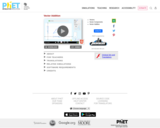
Learn how to add vectors. Drag vectors onto a graph, change their length and angle, and sum them together. The magnitude, angle, and components of each vector can be displayed in several formats.

Make waves with a dripping faucet, audio speaker, or laser! Add a second source or a pair of slits to create an interference pattern.

Learning Goals: Discuss wave properties using common vocabulary. Predict the behavior of waves through varying medium and at reflective endpoints.

Learning Goals: Discuss wave properties using common vocabulary. Predict the behavior of waves through varying medium and at reflective endpoints.

Test the pH of things like coffee, spit, and soap to determine whether each is acidic, basic, or neutral. Visualize the relative number of hydroxide ions and hydronium ions in solution. Switch between logarithmic and linear scales. Investigate whether changing the volume or diluting with water affects the pH. Or you can design your own liquid!
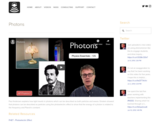
Paul Andersen explains how light travels in photons which can be described as both particles and waves. Einstein showed that photons can be described as particles using the photoelectric effect to show that the energy of a photon is related to the frequency and Planck's constant.
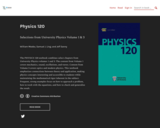
The PHYSICS 120 textbook combines select chapters from University Physics volumes 1 and 3. The content from Volume 1 covers mechanics, sound, oscillations, and waves. Content from Volume 3 covers optics and modern physics. This textbook emphasizes connections between theory and application, making physics concepts interesting and accessible to students while maintaining the mathematical rigor inherent in the subject. Frequent, strong examples focus on how to approach a problem, how to work with the equations, and how to check and generalize the result.

A second semester introductory physics course for life sciences students that looks to deepen students' understanding of biology and chemistry through physics all through the lens of understanding two of the most fundamental particles in the Universe: electrons and photons. The book begins with exploring the quantum mechanical nature of these objects to expand on what students have learned in chemistry and then proceeds to geometric optics (using the human eye as a theme), electrostatics (using membrane potentials), circuits (using the neuron), and finally synthesizing everything in a unit exploring the meaning of "light is an electromagnetic wave."
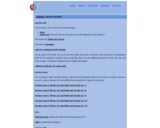
The Physics 205/206 and 210/211 sequences are intended for biology majors. If you're an engineering major, you should be in Physics 221. If you just need a gen ed class, you should be in Physics 130. Physics 205/206 satisfies your physics requirement if you're a biology major transferring to a Cal State. The prerequisites for 205 are Math 141 (precalculus) and Math 142 (trig). Physics 210/211 satisfies your physics requirement if you're a biology major transferring to a UC (or a Cal State). The prerequisites for 210 are Math 141 (precalculus) and Math 142 (trig), and the corequisite is Math 150A (calculus).
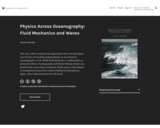
This class reflects material and approaches that were developed over 25 years of teaching undergraduates in the School of Oceanography at UW. While fluid mechanics is traditionally an advanced subject, Oceanography and Marine Biology majors can benefit from a more basic treatment, ideally early in their degree, as foundational material for understanding interdisciplinary topics. That is the motivation for this book.

The online educational resource Physics For Everyone is the scaffolding for a 3 contact hour, 3 credit general education course that conveys the relevance, beauty, and power of physics as a foundation of science and technology in the public interest.
This slide deck provides the outline for the semester-long course. Each week’s lecture topics, with key points to be covered, are highlighted in two slides, which also list writing prompts, problem-solving exercises, and labs. Also, we have curated a list of high-quality online video resources that students (and instructors) should use to help them learn (and teach) physics ideas and concepts using demonstrations, animations, and humor. Many of those videos are parts of larger series and programs, created by some of the most skilled and popular online presenters in the world; that means some of their content is commercially sponsored, but all the content is free to students and instructors. Finally, we have envisioned this course so that students are assessed with a large set of low-stakes, just-in-time-type assignments and laboratory exercises.
This work has been generously supported by New America’s PIT-UN (Public Interest Technology University Network) challenge grant program, and is licensed under a Creative Commons Attribution-Noncommercial-Share Alike 4.0 License.

This is a course for non-science majors that is a survey of the central concepts in physics relating everyday experiences with the principles and laws in physics on a conceptual level. Upon successful completion of this course, students will be able to: Describe basic principles of motion and state the law of inertia; Predict the motion of an object by applying Newtonęs laws when given the mass, a force, the characteristics of motion and a duration of time; Summarize the law of conservation of energy and explain its importance as the fundamental principle of energy as a law of nature; Explain the use of the principle of Energy conservation when applied to simple energy transformation systems; Define the Conservation of Energy Law as the 1st Law of Thermodynamics and State 2nd Law of Thermodynamics in 3 ways; Outline the limitations and risks associated with current societal energy practices,and explore options for changes in energy policy for the next century and beyond; Describe physical aspects of waves and wave motion; and explain the production of electromagnetic waves, and distinguish between the different parts of the electromagnetic spectrum.
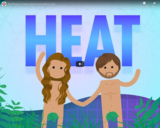
The video resource "The Physics of Heat: Crash Course Physics #22" is included in the "Sociology" course from the resources series of "Crash Course". Crash Course is a educational video series from John and Hank Green.

The video resource "The Physics of Music: Crash Course Physics #19" is included in the "Sociology" course from the resources series of "Crash Course". Crash Course is a educational video series from John and Hank Green.
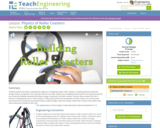
Students explore the physics utilized by engineers in designing today's roller coasters, including potential and kinetic energy, friction, and gravity. First, students learn that all true roller coasters are completely driven by the force of gravity and that the conversion between potential and kinetic energy is essential to all roller coasters. Second, they also consider the role of friction in slowing down cars in roller coasters. Finally, they examine the acceleration of roller coaster cars as they travel around the track. During the associated activity, the students design, build, and analyze a roller coaster for marbles out of foam tubing.

Students are introduced to the physics concepts of air resistance and launch angle as they apply to catapults. This includes the basic concepts of position, velocity and acceleration and their relationships to one another. They use algebra to solve for one variable given two variables.
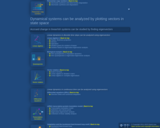
Why do quantitative biologists sometimes claim that mRNA copy numbers are Poisson distributed in simple models of gene transcription? The first video segment addresses this question under the simplifying assumption that mRNA degradation occurs after a well-defined, deterministic lifetime, and the second segment illustrates the same basic concept for the more realistic situation in which degradation is stochastic.
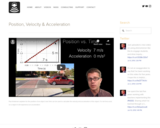
Paul Andersen explains for the position of an object over time can be used to calculate the velocity and acceleration of the object. If a net force acts on a object it will experience an acceleration.
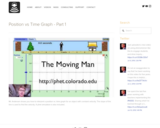
Mr. Andersen shows you how to interpret a position vs. time graph for an object with constant velocity. The slope of the line is used to find the velocity. A phet simulation is also included.